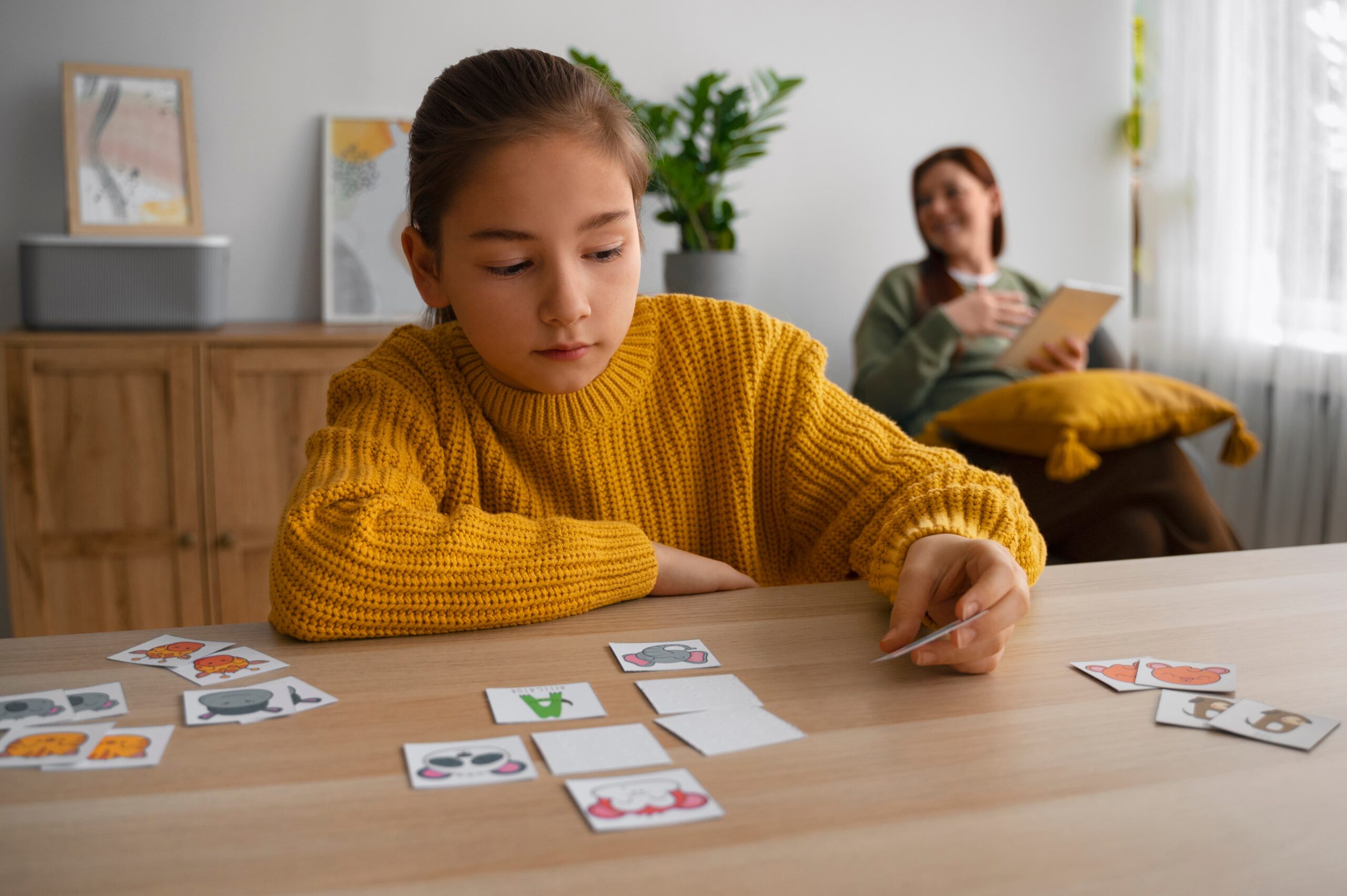Some classroom behaviors can be confusing if you don’t know what’s behind them. Children with autism often miss social cues like tone or gestures, leading to misunderstandings in class. Maryland teachers now use visual aids, PECS, and role play to improve communication. Clear instructions and inclusive practices reduce isolation and support better interaction.
This guide highlights the signals these children often misunderstand, how missed cues can affect learning, and what teachers can do to support meaningful communication for every student in an autism classroom.
How Social Cues Impact Communication in the Autism Classroom
You know how a simple smile, nod, or shift in tone can carry meaning in everyday conversation? For many kids with autism, those small cues aren’t always easy to catch. That’s a big reason why communication in the autism classroom often looks different.

Teach How Gestures, Facial Expressions, and Tone May Be Misread
In Maryland, about 1 in 43 children has autism, and that number continues to rise. A child with autism might not recognize that a teacher’s warm tone is meant to encourage or that a classmate’s quick glance is a silent cue to join a group.
One child might be seen as withdrawn when, in truth, they just process information differently. To change this, more Maryland educators now receive ongoing training on autism. When teachers and classmates better understand these differences, it builds a classroom culture that’s more patient, fair, and supportive.
Explain Why Literal Language Makes Social Interactions Harder
Literal thinking affects how some kids with autism respond to everyday language. Here are common examples of where things can get tricky:
- Idioms like “hold your horses” or “raining cats and dogs”
- Sarcasm or jokes that rely on tone
- Vague instructions like “get ready” without specifics
- Classroom slang or pop culture references
These expressions might seem fun or harmless, but they can confuse kids who interpret language exactly as it’s spoken. Because of this, many classroom special education teams now use visual aids and stick to clear, direct instructions.

Common Classroom Struggles Linked to Missed Social Cues
You’ve probably seen a child rocking back and forth or intensely talking about one topic in an autism classroom. These actions can be misread if you’re not sure what’s behind them.
Identify Behaviors Often Misunderstood by Teachers and Classmates
Some behaviors may stand out but aren’t meant to disrupt. These include:
- Avoiding eye contact
- Hand-flapping or repetitive movements
- Speaking out of turn or using a flat tone
- Focusing deeply on one interest
- Having trouble with group instructions
A national study found that many teachers describe autistic students by behaviors like “difficulty with peers” or “rigid interests.” That limited view can block understanding.
In Maryland, more schools now use tools like Functional Behavior Assessments to guide responses. When teachers recognize what a child is trying to express, they’re more likely to respond in ways that help instead of punishing.
Show How Group Settings Can Create Stress and Isolation
Group activities in a special education classroom can be loud, fast-paced, and unpredictable. For many children with autism, this can trigger stress.
Here’s what may cause challenges:
- Loud or echoing sounds in cafeterias or gymnasiums
- Unstructured time during free play or transitions
- Pressure to respond quickly in group discussions
- Sensory discomfort from crowded spaces or lights
Strategies That Help Kids with Autism Understand Social Cues
Some kids don’t naturally pick up on social rules the way others do. That’s why teaching these skills needs to be intentional in a classroom special education setting.
Use Visual Aids to Make Social Rules More Concrete
Visual tools can help children understand what’s expected without having to guess. These include:
- Picture schedules for daily routines
- Social stories that walk through common situations
- Color-coded rules and symbols
- Visual cues for emotions and behavior
- Illustrated step-by-step guides
In one study, 27% of students with autism mastered certain tasks after using color-coded visuals. Teachers in Maryland now regularly use cards, diagrams, and charts to help reduce stress, improve focus, and make classroom rules easier to follow.
Practice Real-Life Situations Through Role Play and Modeling
Kids with autism often benefit from rehearsing real-life interactions. That’s where role play comes in handy with activities that include:
- Practicing how to start or end a conversation
- Taking turns during group games
- Responding to a classmate’s tone or expression
- Asking for help or offering help to others
These tools help kids build awareness, even during everyday challenges like group time or sensory play for adults adapted for classroom use.

Tools That Support Social Communication in the Classroom
In a special education classroom, the right supports can open up new ways for children with autism to connect, participate, and feel seen.
Introduce PECS to Help Children Express Needs and Initiate Interaction
PECS, or Picture Exchange Communication System, gives children a simple and effective way to communicate using images. It’s especially helpful for nonverbal or minimally verbal students:
- Children use picture cards to request items or activities.
- The system encourages back-and-forth interaction.
- It helps reduce frustration and problem behaviors.
- It helps develop independence.
Many Maryland classrooms use PECS daily, whether during snack time, center play, or guided learning, because it helps children express their needs clearly.
Use Technology to Simulate and Practice Social Scenarios
Technology makes it easier to practice social skills in a way that feels natural. Tools often used in classrooms include:
- Video modeling of classroom routines
- Apps with customizable role-play activities
- Speech-generating devices for nonverbal students
- Virtual reality for practicing real-world interactions
- Robotics for turn-taking or basic conversations
Some tech-based activities are even adapted from sensory play for adults, helping kids manage stimulation while learning social rules.
How Teachers Can Build an Inclusive Autism Classroom
In an autism classroom, building a space where all kids feel understood starts with small but consistent changes in how teachers support interaction and inclusion.
Encourage Peer Modeling to Demonstrate Positive Social Behavior
You’ve probably seen kids copy what their classmates do. It’s a natural part of learning. Peer modeling works the same way. Educators often use peer pairing during:
- Group activities
- Recess or center time
- Partnered learning tasks
This teaches empathy, reduces stigma, and gives all students a chance to lead.
Normalize Different Communication Styles to Reduce Misunderstanding
Not all kids use words to communicate. Some rely on pictures, gestures, or speech devices, and that’s okay.
Teachers can support inclusion by:
- Displaying visual supports around the classroom
- Using multiple ways to give instructions
- Talking about communication differences openly
- Encouraging classmates to respond to all types of communication
Schools that normalize these differences help every student feel like they belong.
Building Real Understanding in Autism Classrooms
Supporting communication starts with recognizing the small signals many kids with autism may miss. Jade ABA Therapy believes that improving how children respond to social cues in every Maryland autism classroom begins with strategies grounded in empathy, structure, and practice.
Jade ABA Therapy works closely with families and schools to build communication that works for each child. If you’re looking for support that helps your child participate, connect, and succeed in the classroom, contact us today.



